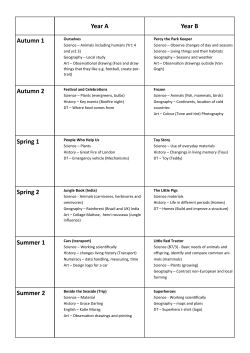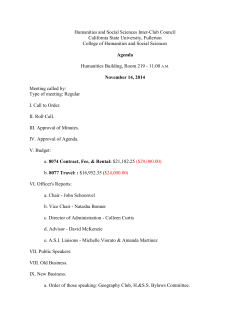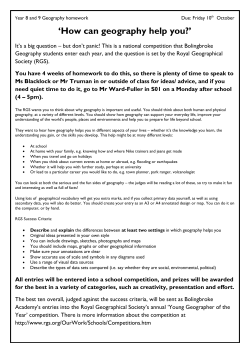
Southwest Asia: Physical Geography
Chapter 14 Section 2 Objectives In this section you will: • Learn about the major landforms of Southwest Asia. • Find out what the two most important resources in Southwest Asia are. • Examine how people use the land in Southwest Asia. Southwest Asia: Physical Geography Chapter 14 Section 2 Key Terms • oasis (oh AY sis) n. an area in a desert region where fresh water is usually available from an underground spring or well • petroleum (puh TROH lee um) n. an oily liquid formed from the remains of ancient plants and animals; a fuel Southwest Asia: Physical Geography Chapter 14 Section 2 Key Terms (continued) • nonrenewable resource (nahn rih NOO uh bul REE sawrs) n. a natural resource that cannot be quickly replaced once it is used • standard of living (STAN durd uv LIV ing) n. a measurement of a person’s or a group’s education, housing, health, and nutrition Southwest Asia: Physical Geography Chapter 14 Section 2 Southwest Asia stretches from the Caucasus Mountains to the Gulf of Aden. Its nations are: • Armenia • Lebanon • Saudi Arabia • Azerbaijan • Iran • Syria • Bahrain • Iraq • Turkey • Cyprus • Israel • Jordan • Oman • United Arab Emirates • Kuwait • Qatar Southwest Asia: Physical Geography • Yemen Chapter 14 Section 2 Nearly two thirds of the land in Southwest Asia is desert, and many parts of the region receive little rain. Much of Southwest Asia has an arid or a semiarid climate, with temperatures as high as 125°F during the day. In the Arabian Peninsula, the Rub’ al-Khali (“Empty Quarter”), which is almost as big as Texas, is the largest all-sand desert in the world. Southwest Asia: Physical Geography Chapter 14 Section 2 Deserts also cover much of Iran, Iraq, and Syria. Some of the region’s deserts are covered with sand, while others are rocky. Sometimes, an oasis in the desert can support a community of people. Southwest Asia: Physical Geography Chapter 14 Section 2 Southwest Asia: Physical Southwest Asia: Physical Geography Chapter 14 Section 2 Some of the most fertile soil in the world lies along the Tigris and Euphrates rivers. These rivers begin in the mountains of Turkey, flow south through Iraq, and join to form the Shatt-al-Arab, which flows into the Persian Gulf. In ancient times, the land between these two rivers supported one of the world’s first civilizations, known as Mesopotamia. Southwest Asia: Physical Geography Chapter 14 Section 2 The Zagros Mountains extend along the western part of Iran, and the Elburz Mountains extend along the northern coast of Iran. The mountains give way to large plateaus in both Turkey and Iran. Southwest Asia: Physical Geography Chapter 14 Section 2 Seas and Gulfs of Southwest Asia Red Sea • separates Southwest Asia and Africa Mediterranean Sea • forms Southwest Asia’s western border Black Sea • forms Turkey’s northern border Caspian Sea • forms part of the boundary between Southwest Asia and Central Asia Persian Gulf • separates Iran from the Arabian Peninsula Southwest Asia: Physical Geography Chapter 14 Section 2 The coasts of the Mediterranean, Black, and Caspian seas as well as the mountainous areas of the region have a Mediterranean climate. Regions that have a Mediterranean climate have hot, dry summers and mild, rainy winters. Southwest Asia: Physical Geography Chapter 14 Section 2 Southwest Asia: Climate Regions Southwest Asia: Physical Geography Chapter 14 Section 2 One of the most important resources in Southwest Asia is petroleum, which is a nonrenewable resource. Large deposits of petroleum are found in only a few places on Earth, and the countries that have them play a key role in the world’s economy. Southwest Asia has more than half of the world’s oil reserves, and oil is its greatest export. Southwest Asia: Physical Geography Chapter 14 Section 2 Oil wealth allows many Southwest Asian countries to increase the standard of living of their people. Some countries in Southwest Asia have little or no oil. These countries have a lower standard of living than do their oil-rich neighbors. Southwest Asia: Physical Geography Chapter 14 Section 2 Southwest Asia: Natural Resources Southwest Asia: Physical Geography Chapter 14 Section 2 Another important resource in Southwest Asia is water. Much of the region has a dry climate, so people usually must irrigate their land in order to grow crops. To irrigate their land, people pump water from deep underground wells or use water from rivers and streams. Southwest Asia: Physical Geography Chapter 14 Section 2 However, irrigation cannot solve the problem of water scarcity, and too much irrigation can use up the available water. When a river runs through more than one nation, each nation is affected by the others’ irrigation systems. Southwest Asia: Physical Geography Chapter 14 Section 2 People in Southwest Asia use the land for agriculture, for nomadic herding, and for producing oil. Most of the small percentage of arable land is in the northern part of the region, with commercial farming taking place along the coast. Israel and Turkey grow a wide variety of crops. Southwest Asia: Physical Geography Chapter 14 Section 2 For centuries, Arabic-speaking nomadic herders known as Bedouins have lived in Southwest Asia’s deserts. Today, the Bedouins are 10 percent of the population of Southwest Asia. The Bedouins like to move around, seeking grass and water for their animals, but recent policies have forced many of them to settle in one place. Southwest Asia: Physical Geography
© Copyright 2025









